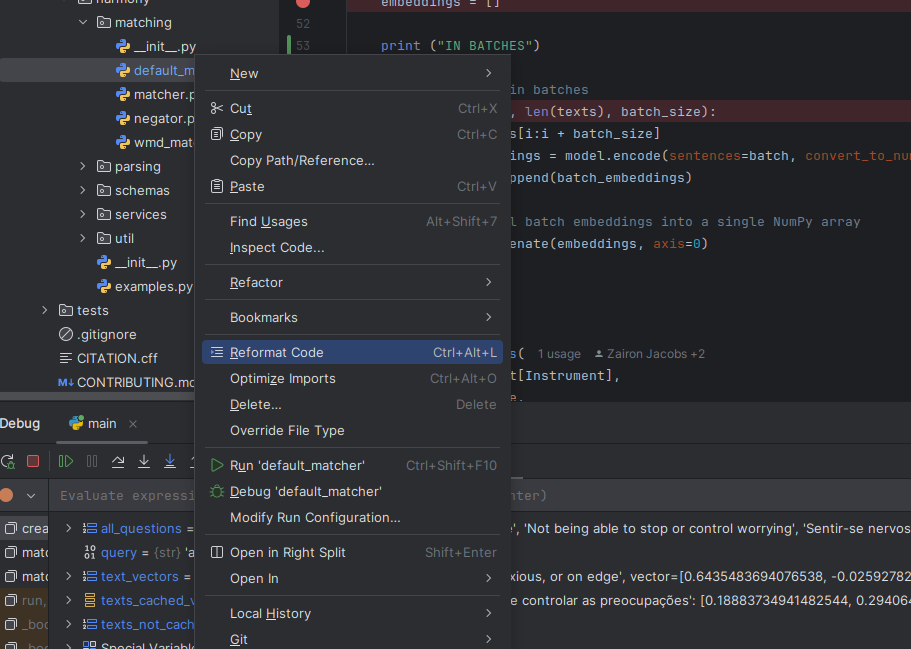Thanks for your interest in contributing to Harmony. This page will give you a quick overview of how things are organized and most importantly, how to get involved.
See also https://harmonydata.ac.uk/contributing-to-harmony/ for more information.
Are you a scientist, researcher, data wrangler, or language maestro? Harmony needs YOU! We're always looking for talented individuals to join our team.
- Contribute to our open-source code: Whether you're a seasoned developer or a curious newbie, your contributions are valued.
- Join the conversation: Share your ideas, suggestions, and feedback on our forum and social media channels.
Participating in an open source project can be very rewarding. Read more about it here!
Please familiarise yourself with Git. You can fork Harmony and make a pull request any time! We're glad to have your contribution.
First, do a quick search to see if the issue has already been reported. If so, it's often better to just leave a comment on an existing issue, rather than creating a new one. Old issues also often include helpful tips and solutions to common problems. You should also check the troubleshooting guide to see if your problem is already listed there.
If you're looking for help with your code, consider posting a question on the GitHub Discussions board. Please understand that we won't be able to provide individual support via email. We also believe that help is much more valuable if it's shared publicly, so that more people can benefit from it.
There are lots of ways you can contribute to Harmony! You can work on code, improve the API, or add code examples.
- Write code
- Improve unit tests or integration tests
- Add new functionality to Harmony
- Improve Harmony's documentation
- Add integrations to other LLMs or LLM providers such as OpenAI, IBM, or similar
- Add integrations from your website to Harmony
- Publicise Harmony in web forums such as Reddit, HuggingFace forum, Quora, or similar
- Create example notebooks, such as Jupyter Notebook, RStudio, or Google Colab
- Investigate bugs and issues in Harmony
- Review and comment on pull requests
- Cite Harmony in your blogs, papers, and articles
- Talk about Harmony on social media. Don't forget to tag us on Twitter @harmony_data, Instagram @harmonydata, Facebook @harmonydata, LinkedIn @Harmony, and YouTube @harmonydata!
- Starring and forking Harmony on Github!
The issue list is in the Github repository. You can view the open issues, pick one to fix, or raise your own issue. Even if you're not a coder, feel free to raise an issue.
- Issues for the core Python library are here: https://github.com/harmonydata/harmony/issues
- Issues for the API are here: https://github.com/harmonydata/harmonyapi/issues
- Issues for the front end are here: https://github.com/harmonydata/app/issues
- Issues for the R port are here: https://github.com/harmonydata/harmony_r/issues
Harmony is mostly coded in Python. We use Pycharm IDE by JetBrains. Please ensure you are familiar with Python, HuggingFace, and FastAPI, or Javascript and React if you want to work on the front end.
Please make sure all code you commit is linted using the Pycharm default linter. If you use a different one (such as VS Code's linter, or pylint), this will make the code history hard to follow, so please be consistent.
See the example screenshot below of Pycharm's formatter to format your code correctly:
Harmony uses the pytest framework for testing. For more info on this, see the pytest documentation. To be interpreted and run, all test files and test functions need to be prefixed with test_.
The Harmony Python library https://github.com/harmonydata/harmony is the core Harmony functionality. Most of the logic is in this repo. This repo has unit tests which run automatically on commits to main.
However, the Harmony API repo https://github.com/harmonydata/harmonyapi uses the Harmony Python library as a submodule. When you update the Python library, please run the unit tests and integration tests in the API repo to check nothing is broken - including the Selenium tests which test the browser app end to end. You will need to install Selenium to run the tests.
Since the API repo includes the Python library as a submodule, when you update the Python library, you will need to update the submodule (in the harmonyapi repo, cd into the submodule folder and do git pull, then cd out and do git add, commit and push). We recommend you familiarise yourself with Git submodules.
Finally, the app repo https://github.com/harmonydata/app is the React front end. Please check you can run this repo locally also before you start contributing. To point the front end repo to a local copy of your API repo, please change the file .env to point to http://localhost:8000.
When you make a commit, if it is for issue #54, please put #54 in the issue description. This way Github will track the commit and link it to the issue in the Github issues list.
If you'd like to contribute to this project, you can contact us at https://harmonydata.ac.uk/ or make a pull request on our Github repository. You can also raise an issue.
